Taking a ‘Tech-Agnostic’ View on Propulsion, SEMA Sheds Light on the New Ideas (and Business Opportunities) Transforming the Specialty Market
By Michael Imlay
The direction of automotive propulsion is a hot-button issue for many in the aftermarket. Traditionally, a culture of internal-combustion engine (ICE) performance pervades the industry. Even appearance modifications often take their cues from ICE vehicles whose throaty roars remain synonymous with speed and prowess. But recent pushes toward battery electric vehicles (BEVs) and other “decarbonizing” technologies are upsetting that long-established equilibrium, which makes for some heated discussions.
The direction of automotive propulsion is a hot-button issue for many in the aftermarket. Traditionally, a culture of internal-combustion engine (ICE) performance pervades the industry. Even appearance modifications often take their cues from ICE vehicles whose throaty roars remain synonymous with speed and prowess. But recent pushes toward battery electric vehicles (BEVs) and other “decarbonizing” technologies are upsetting that long-established equilibrium, which makes for some heated discussions.
Officially, SEMA opposes one-size-fits-all mandates to eliminate emissions through any single technology. The association believes that cleaner ICE engines along with BEVs, hybrids, hydrogen and CNG, and other alternative fuels and innovations all have a role to play in achieving decarbonization goals. What’s more, SEMA views the specialty automotive industry as a prime laboratory for technological development. Let the industry do what it has always done best, and see the ingenuity that results.
Take for example the 2023 SEMA Show’s FutureTech Studio, which offered proof of that concept this past November in Las Vegas. The section represented an evolution of the former SEMA Electrified exhibit from years prior, this time taking a “tech-agnostic”
approach to the wide array of emerging propulsion technologies. Designed as an immersive exhibit, the FutureTech Studio featured displays and demonstrations of advanced parts and equipment alongside Show vehicles highlighting how these inventions are being deployed.
“Obviously there’s been a lot of discussion about the automobile and emissions and what place they occupy in global society,” said Andy Tompkins, SEMA trade show director. “I think people realize there is change happening and change is constant. We saw a pent-up demand for new business opportunities at the 2023 SEMA Show, so it was good to gather in Las Vegas to discuss them. On a macro level, you saw the industry’s future reflected throughout the Show floor, with a good amount of it coalescing at the SEMA FutureTech Studio.”
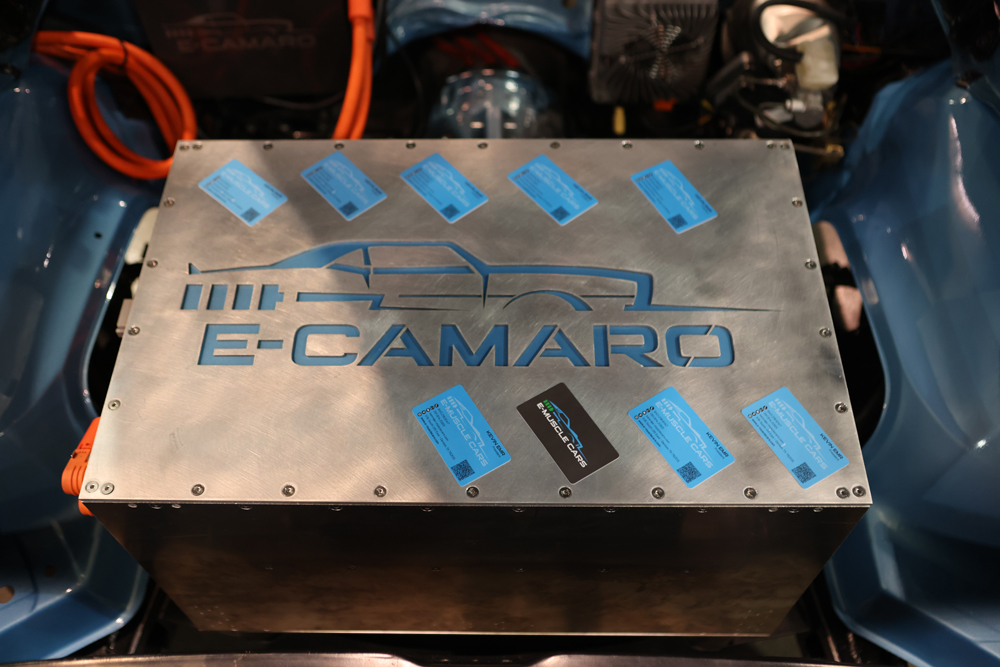
A Growing Market Space
“We wanted to put a shine on all the emerging technologies and demonstrate inclusivity of everything the market offers,” added SEMA Director of Vehicle Technology Luis Morales. “In addition to renaming the section the SEMA FutureTech Studio, we greatly expanded both the section’s content and its footprint on the Show floor. We also reserved a number of booths around the space for exhibitor companies developing and supplying products and tools related to future-focused technologies.”
In all, the studio occupied more than 22,000 sq. ft. in the Las Vegas Convention Center’s Central Hall, highlighting the growing impact of modern propulsion systems on the industry and its consumers. Within the FutureTech Studio itself, there were 50 overall displays addressing the latest electric-vehicle (EV) and alternative-fuel and powertrain vehicle and component trends, along with 29 vehicles representing a wide range of applications. These included a fuel-cell-electric longhall truck cab developed through a joint partnership between Toyota Motors of North America and Kenworth, along with a number of e-fuel vehicle and motorcycle conversions. There was also a solar-powered Lightship RV trailer that wowed attendees with its futuristic design and versatility.
Morales believes that grasping this evolving vehicle landscape is key to “future-proofing” aftermarket businesses of all types. “Our vision of the future is not just electric,” he said. “The alternative fuels are especially exciting to see—there are more players and product developers entering this virgin fuel market, meaning you can now easily convert vehicles running on typical gasoline or diesel to run on ethanol, propane or other alternative fuels.”
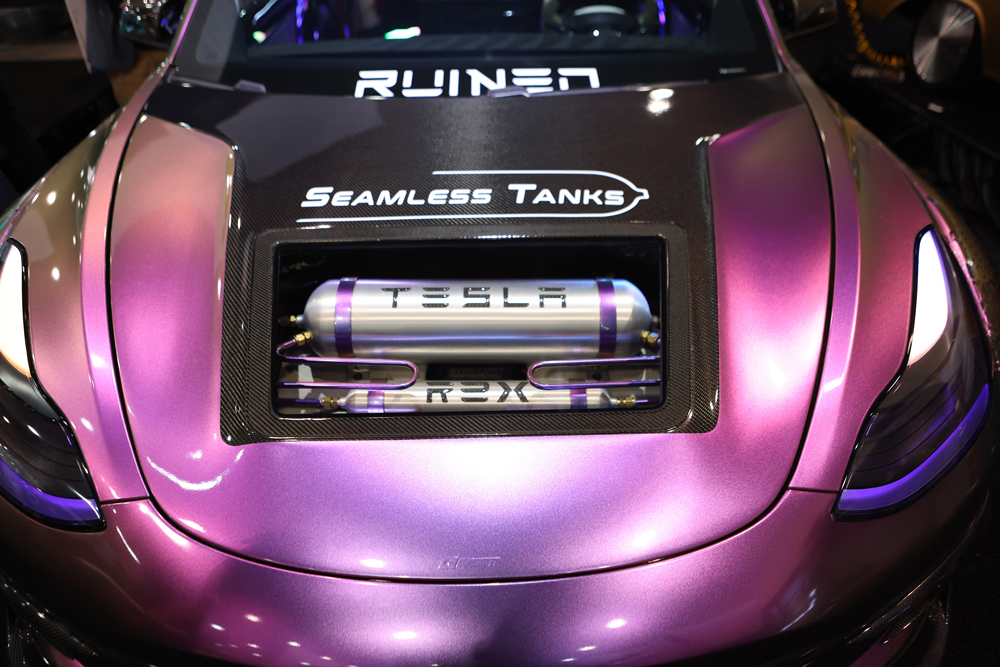
As an example, Morales pointed to Divergent, which is pioneering new approaches to automotive chassis-building that incorporate 3D-printed nodes connected by fiber tubing. The celebrated offshoot of this innovation is the Czinger Vehicles 21c, a hybrid-driven hypercar that has gathered so much buzz it was named one of Time magazine’s Best Inventions of 2023.
“They’re sticking with internal-combustion vehicles,” explained Morales. “The motorcycle they displayed at the FutureTech Studio was actually an ICE. But they are proponents of renewable fuels—that was their main message. They’ll continue to develop products around ICE vehicles while promoting renewables.”
In other words, Morales said, ICEs will remain viable for decades, albeit with changes, and the aftermarket will continue to have a significant role in their evolution.
But the Show section was more than a museum of project and concept vehicles. It featured advanced manufacturing and component displays, EV “crate motors” for conversions, “skateboard” platforms for vehicle builds and ethanol conversion kits. In addition, there was a FutureTech “extension” of the New Products Showcase for companies to spotlight their latest offerings to help attendees explore the novel opportunities the market space is opening up.
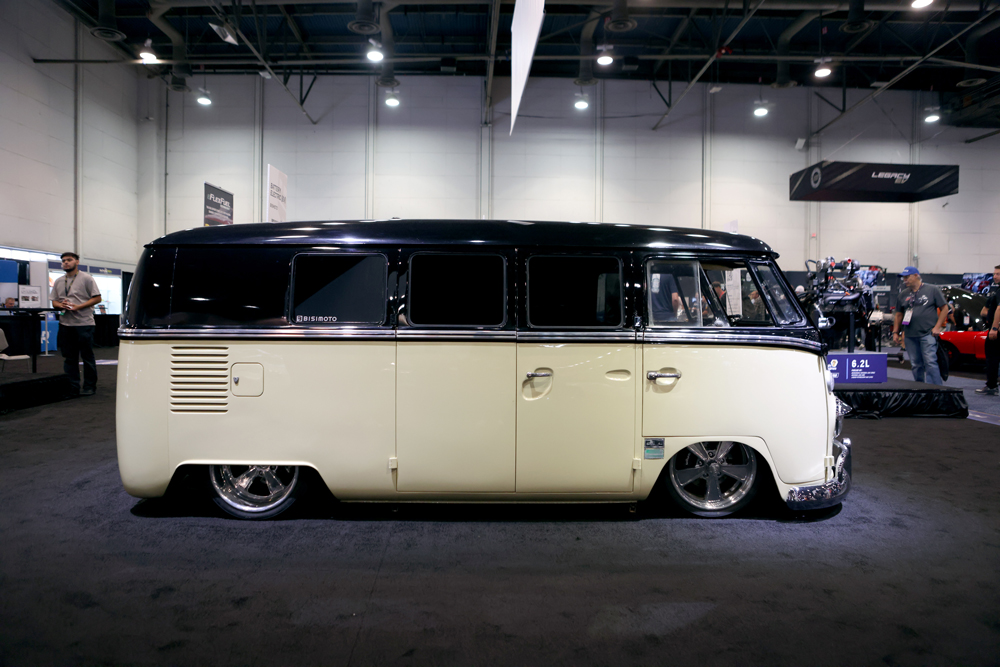
Chad Hrencecin of Electrified Garage was among the numerous buyers checking out the section, and was enthused to find several innovations for his Ocala, Florida-based EV repair operation. “A lot of people are realizing [EV and alternate fuels] are not going away. We’ve been working with Legacy EV, Torque Trends and a lot of companies that are here to make new conversions and one-off projects,” he explained. A self-described “off-roader guy,” he was especially impressed by an EV-conversion sand rail featuring a VW off-road chassis. “I haven’t seen anything like that before,” he emphasized.
Imparting Skills and Knowledge
Because education in new technology is an equally pressing need, the SEMA FutureTech Studio also included a seminar stage and discussion area. In conjunction with SEMA Show Education, that stage hosted a total of nine different vehicle technology “micro-learning” sessions throughout the Show Week.
“We wanted to introduce the industry to technology, show its benefits, and help attendees get their workforces ready to handle it,” Morales explained. “Two exhibitors shared certification and training opportunities, because as you as you introduce these new technologies—whether they’re alternative fuels, BEVs or related high-voltage applications—your technicians need to know how to safely handle them.”
In addition, there were a variety of live demonstrations, including a 90-min. Scorpion EV “crate motor” conversion of a Shelby Cobra Replica right on the Show floor.
Meanwhile, new-tech tools and equipment of all sorts are developing at a surprisingly rapid pace, especially for vehicle builders and service garages. Alex Parker, president of Redline Detection, was among the seminar presenters who addressed the emerging opportunities in the market. Seeing the transformation that’s coming, why wouldn’t a business want to add capabilities to address new markets, she asked.
“My company has been a leader in diagnostic leak detection in naturally aspirated and boosted high-pressure diagnostics both on the OEM side and in the aftermarket,” she explained. “We reached a point that we had to make a decision about when to invest in developing EV diagnostic technology. Quite honestly, it was a little scary because we weren’t sure the market was there, but I really believe that people in our industry are innovators at heart.”
Seeing the catastrophic risks of an EV battery leak to a shop, not to mention a vehicle owner, Redline Detection developed and introduced its Battery + Coolant Leak Detector. It connects to the battery enclosure on or off the vehicle and gives audible and visual pass/fail alerts tailored to each battery and vehicle type.
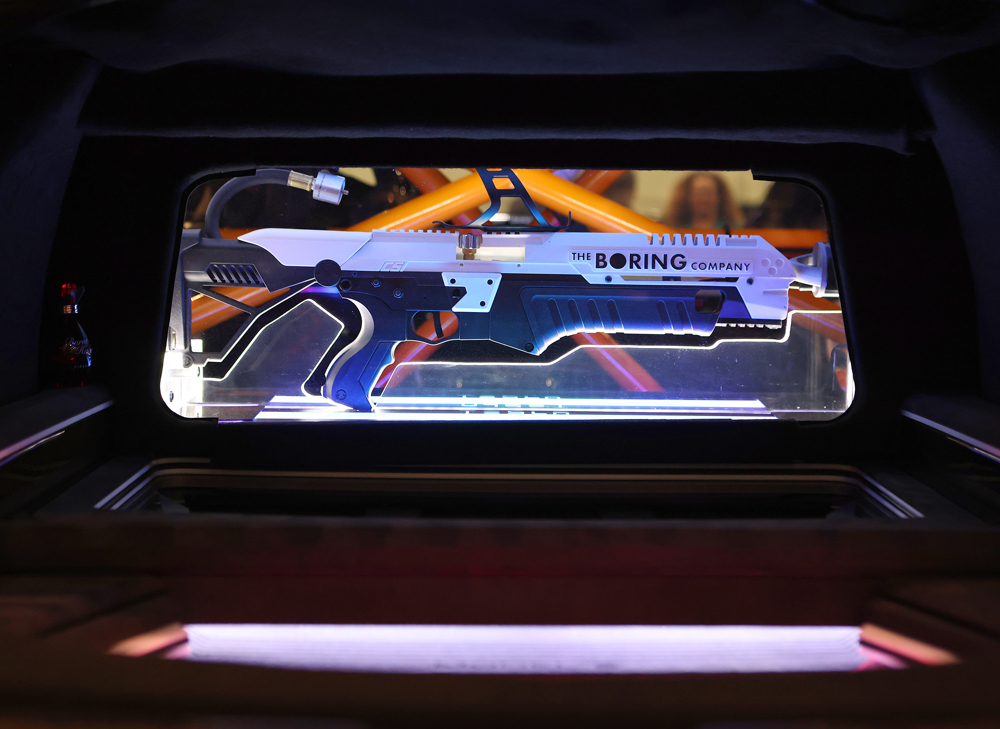
“Our approach [to the EV space] is not an ‘either/or.’ EVs are just one more innovation that we need to learn how to work on,” Parker said.
That message, which echoes SEMA’s tech-agnostic philosophy toward the marketplace, was not lost on FutureTech Studio visitors, which included mainstream journalists and lawmakers alongside general attendees. “We gave a lot of tours,” said Morales, which allowed SEMA to educate a wider audience on the innovative environmental solutions that the aftermarket is already bringing to the table.
“Creating an area like this gives new-tech companies a natural place to fit into the SEMA Show,” added Morales. “They’re seeking ROI and want to make sure they’re positioned where they technically belong. The FutureTech Studio is inclusive of developing technologies for emerging trends and gives these companies a means to grow their businesses.”
Plus, it’s a hub of collaboration—something that will be important to the entire industry as innovations proliferate and “shake out.”
“That’s actually really important,” continued Morales. “We’re bringing in companies that have been developing over the past three to four years or so. They’re getting to a very established state and exploring collaborations. For example, there weren’t that many conversion products a few years ago, but now you see a significant amount of complete kits offered in the market today. That’s all because of those industry collaborations.”
Lightship RV co-founder Ben Parker said that spirit of collaboration was an unexpected, added benefit when his company signed up to exhibit its fully electric trailer. Parker and his startup partner Toby Kraus left Tesla hoping to revolutionize the overlanding space. The result of their collaboration is the L1 tow trailer. Energized by rooftop solar panels, the unit also features an electric motor that can sync with an EV truck to reduce drag, extending the toy hauler’s range. In a pinch, the trailer can also recharge an EV or even power a small home. The trailer generated a lot of interest and valuable feedback from Show attendees, and Parker found his discussions and sharing of ideas with other exhibitors especially helpful.
“We’ve been to other shows for our market, but [the SEMA Show] is the biggest and a dream come true for us to be here with our RV,” he noted. “We start production and go to market in 2024, so being at the SEMA Show now is a huge deal for us.”
Expanding Traditional Markets
Although the FutureTech Studio obviously benefits pioneers like Lightship RV and similar innovators within the alternative-propulsion space, traditional aftermarket businesses are also finding new opportunities, including accessorizers. A case in point, said Morales, is the growing interest in modification products for Teslas and other new-tech vehicles.
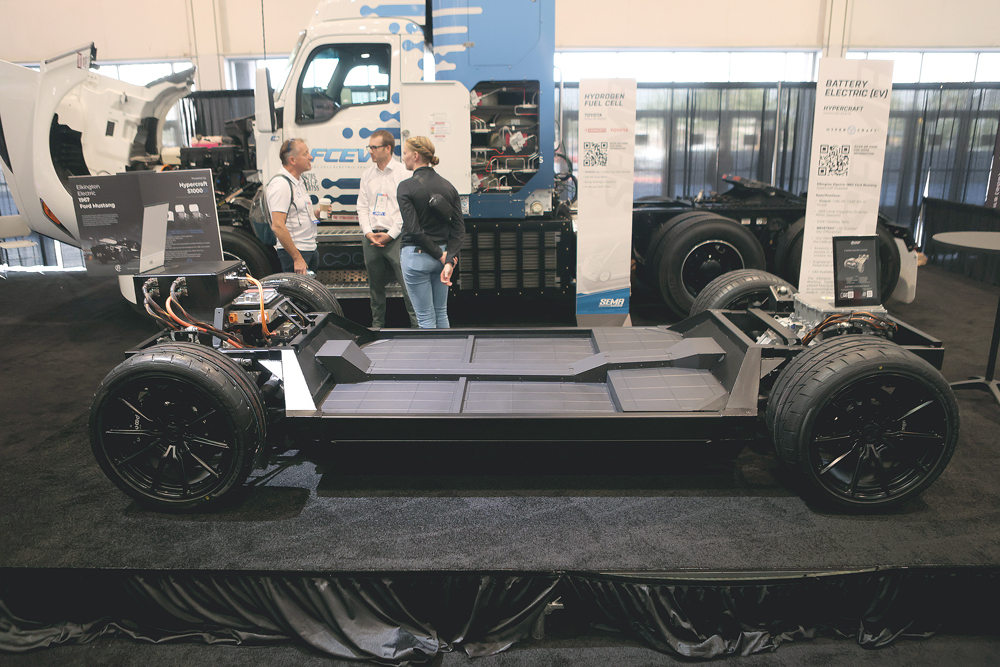
“For a while we saw a lot of them being kept stock because a lot of folks treated them as commuter vehicles… If I’m just going from point A to point B, I don’t really care about what I do with it,” he explained.
“But now the market is gaining an enthusiast following. I compare it to the JDM [Japanese domestic market] phenomenon of the late ‘90s, early ’00s, when a lot of young enthusiasts were modifying Hondas. Suddenly, everybody wanted to accessorize, whether it was wheels, performance parts or exterior appearance items. We’re starting to see that with the Tesla market with vehicles becoming pretty heavily modified through wheels, aerodynamic packages, interior rollcages, suspension modifications and interior audio improvements. We want to spotlight this trend in the FutureTech Studio because it’s a growing part of the industry.”

In fact, the FutureTech Studio plugs into wider SEMA efforts to assist association members in understanding and adopting and integrating emerging technologies into their business models where applicable.
“We’re creating an area that will help us embrace new members as more of these tech companies discover SEMA and see its benefits,” noted Morales. “Obviously the Show is an annual opportunity, but our goal is to engage with these companies year round.”
That in turn will benefit SEMA members representing the wider aftermarket. “We got lot of positive feedback from the 2023 studio, and our goal going into next year is continue expanding the content to make it even more inclusive of other technologies.
So for example, if we see a larger spike in e-fuels coming in and playing a bigger part into the aftermarket, we’ll shine a light on it. We want to make sure that everybody is aware of these new technologies as they’re coming into the industry.”





